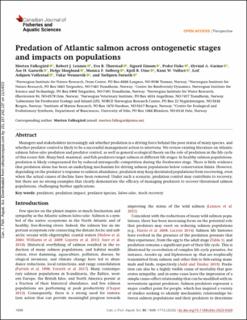| dc.contributor.author | Falkegård, Morten | |
| dc.contributor.author | Lennox, Robert | |
| dc.contributor.author | Thorstad, Eva Bonsak | |
| dc.contributor.author | Einum, Sigurd | |
| dc.contributor.author | Fiske, Peder | |
| dc.contributor.author | Garmo, Øyvind Aaberg | |
| dc.contributor.author | Garseth, Åse Helen | |
| dc.contributor.author | Skoglund, Helge | |
| dc.contributor.author | Solberg, Monica Favnebøe | |
| dc.contributor.author | Utne, Kjell Rong | |
| dc.contributor.author | Vollset, Knut | |
| dc.contributor.author | Vøllestad, Leif Asbjørn | |
| dc.contributor.author | Wennevik, Vidar | |
| dc.contributor.author | Forseth, Torbjørn | |
| dc.coverage.spatial | Atlantic | en_US |
| dc.date.accessioned | 2023-11-15T12:24:04Z | |
| dc.date.available | 2023-11-15T12:24:04Z | |
| dc.date.created | 2023-08-07T12:49:54Z | |
| dc.date.issued | 2023 | |
| dc.identifier.citation | Canadian Journal of Fisheries and Aquatic Sciences. 2023, 80 (10), 1696-1713. | en_US |
| dc.identifier.issn | 0706-652X | |
| dc.identifier.uri | https://hdl.handle.net/11250/3102731 | |
| dc.description.abstract | Managers and stakeholders increasingly ask whether predation is a driving force behind the poor status of many species, and whether predator control is likely to be a successful management action to intervene. We review existing literature on Atlantic salmon Salmo salar predation and predator control, as well as general ecological theory on the role of predation in the life cycle of this iconic fish. Many bird, mammal, and fish predators target salmon at different life stages. In healthy salmon populations, predation is likely compensated for by reduced intra-specific competition during the freshwater stage. There is little evidence that predation alone has been an underlying mechanism for driving salmon populations below conservation limits. However, depending on the predator’s response to salmon abundance, predation may keep decimated populations from recovering, even when the actual causes of decline have been removed. Under such a scenario, predation control may contribute to recovery, but there are no strong examples that clearly demonstrate the efficacy of managing predators to recover threatened salmon populations, challenging further applications. | en_US |
| dc.description.abstract | Predation of Atlantic salmon across ontogenetic stages and impacts on populations | en_US |
| dc.language.iso | eng | en_US |
| dc.rights | Navngivelse 4.0 Internasjonal | * |
| dc.rights.uri | http://creativecommons.org/licenses/by/4.0/deed.no | * |
| dc.subject | predators | en_US |
| dc.subject | predation impact | en_US |
| dc.subject | predator species | en_US |
| dc.subject | Salmo salar | en_US |
| dc.subject | Stock recovery | en_US |
| dc.title | Predation of Atlantic salmon across ontogenetic stages and impacts on populations | en_US |
| dc.title.alternative | Predation of Atlantic salmon across ontogenetic stages and impacts on populations | en_US |
| dc.type | Peer reviewed | en_US |
| dc.type | Journal article | en_US |
| dc.description.version | publishedVersion | en_US |
| dc.rights.holder | © 2023 The Authors | en_US |
| dc.subject.nsi | VDP::Zoologiske og botaniske fag: 480 | en_US |
| dc.subject.nsi | VDP::Zoology and botany: 480 | en_US |
| dc.source.pagenumber | 1696-1713 | en_US |
| dc.source.volume | 80 | en_US |
| dc.source.journal | Canadian Journal of Fisheries and Aquatic Sciences | en_US |
| dc.source.issue | 10 | en_US |
| dc.identifier.doi | 10.1139/cjfas-2023-0029 | |
| dc.identifier.cristin | 2165261 | |
| dc.relation.project | Norges forskningsråd: 280308 | en_US |
| dc.relation.project | Norges forskningsråd: 160022 | en_US |
| cristin.ispublished | true | |
| cristin.fulltext | original | |
| cristin.qualitycode | 2 | |

